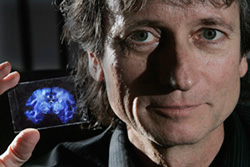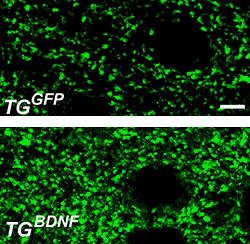Growth Factor Protects Key Brain Cells in Alzheimer’s Models
UC San Diego study in animals may pave way
for novel approach to treating Alzheimer’s disease
Debra Kain | February 9, 2009

Mark Tuszynski, professor of neurosciences at UCSD, holds slide with a cross section of a monkey's brain on Friday. Tuszynski and colleagues published a paper reporting significant results treating animal models with Alzheimer's like symptoms.
Credit: photo by Eduardo Contreras/
San Diego Union-Tribune.
copyright 2009 San Diego Union-Tribune
Memory loss, cognitive impairment, brain cell degeneration and cell death were prevented or reversed in several animal models after treatment with a naturally occurring protein called brain-derived neurotrophic factor (BDNF).
The study by a UC San Diego-led team — published Sunday in issue of Nature Medicine — shows that BDNF treatment can potentially provide long-lasting protection by slowing, or even stopping the progression of Alzheimer’s disease in animal models.
“The effects of BDNF were potent,” said Dr. Mark Tuszynski, professor of neurosciences at the UC San Diego School of Medicine and neurologist at the Veterans Affairs San Diego Health System. “When we administered BDNF to memory circuits in the brain, we directly stimulated their activity and prevented cell death from the underlying disease.”
BDNF is normally produced throughout life in the entorhinal cortex, a portion of the brain that supports memory. Its production decreases in the presence of Alzheimer’s disease. For these experiments, the researchers injected the BDNF gene or protein in a series of cell culture and animal models, including transgenic mouse models of Alzheimer’s disease; aged rats; rats with induced damage to the entorhinal cortex; aged rhesus monkeys, and monkeys with entorhinal cortex damage.
In each case, when compared with control groups not treated with BDNF, the treated animals demonstrated significant improvement in the performance of a variety of learning and memory tests. Notably, the brains of the treated animals also exhibited restored BDNF gene expression, enhanced cell size, improved cell signaling, and activation of function in neurons that would otherwise have degenerated, compared to untreated animals. These benefits extended to the degenerating hippocampus where short-term memory is processed, one of the first regions of the brain to suffer damage in Alzheimer’s disease.

Increase in synapses between neurons after BDNF treatment in the AD mouse model
The demonstration of the effectiveness and safety of BDNF administration in animals provides “a rationale for exploring clinical translation” to humans, the team concluded, suggesting that the protective and restorative effects of BDNF on damaged neurons and neuronal signaling may offer a new approach to treating Alzheimer’s disease.
This work builds on previous studies by Tuszynski and others, demonstrating the therapeutic affects of nerve growth factor (NGF) administered to patients with Alzheimer’s disease. In 2001, Tuszynski and his team at the Medical Center performed the first surgical implants of NGF genes into the brains of Alzheimer’s patients, with follow-up results showing these patients experienced a possible slowing in cognitive decline and increased metabolic function in the brain. The NGF studies continue today, with Phase 2, multi-center studies currently underway.
“NGF therapy aims to stimulate the function of specific cholinergic neurons, which are like the air traffic controllers of the brain, helping to direct the activities of cells in broad regions of the brain,” Tuszynski explained. However, he added that the benefits of NGF therapy, if validated in ongoing trials, will not be curative. Eventually, the effect of the NGF “boost” will be countered by the widespread death of neurons in the cerebral cortex as a result of advancing Alzheimer’s disease.
“In contrast, BDNF acts directly on dying cells in specific memory circuits of the brain,” Tuszynski said. “In this series of studies, we have shown that BDNF targets the cortical cells themselves, preventing their death, stimulating their function, and improving learning and memory. Thus, BDNF treatment can potentially provide long-lasting protection by slowing, or even stopping disease progression in the cortical regions that receive treatment.”
The protective and restorative effects of BDNF occurred independently of the build-up of amyloid, a protein that accumulates in the brain to form plaques in Alzheimer’s disease. Many current experimental treatments for Alzheimer’s disease target amyloid production, so the potential role of BDNF as an alternative protective intervention is of great potential interest, said Tuszynski. Because BDNF targets a different set of disease mechanisms than amyloid modulation, there is also potential to combine BDNF and amyloid-based treatments, theoretically providing a two-pronged attack on the disease.
The study was supported by the National Institutes of Health, the California Regional Primate Research Center, the Veterans Administration, the Alzheimer’s Association, the State of California, the Dr. Miriam and Sheldon G. Adelson Medical Research Foundation and the Shiley Family Foundation. Tuszynski is scientific founder of Trophin Therapeutics, a company that may potentially benefit from the research results.
Study co-authors are Alan H. Nagahura, David A. Merrill, Shingo Tsukada, Brock E. Schroeder, Gideon M. Shaked, Ling Want, Armin Blesch, James M. Conner, Edward Rockenstein, Edward H. Koo, and Eliezer Masliah of the UC San Diego Department of Neurosciences, and Andrea A. Chiba of the UC San Diego Departments of Neurosciences and Cognitive Science. Giovanni Coppola and Daniel Geschwind of the Program in Neurogenetics, Department of Neurology at UCLA, and Albert Kim and Moses V. Chao, Skirball Institute of Biomolecular Medicine at New York University School of Medicine.

|